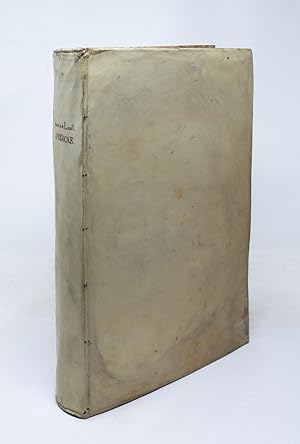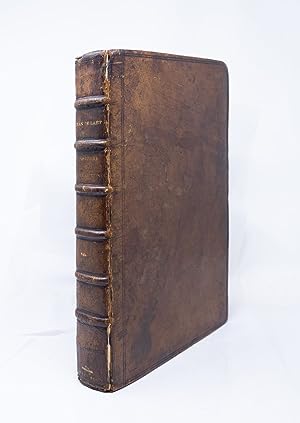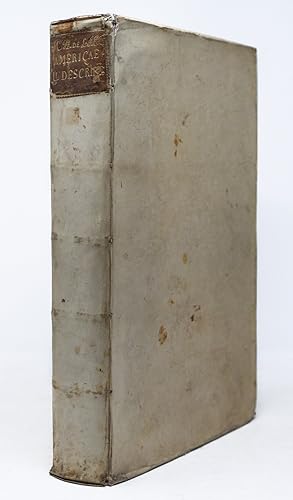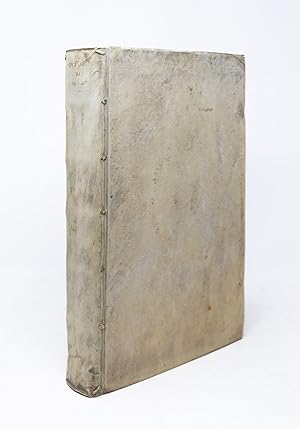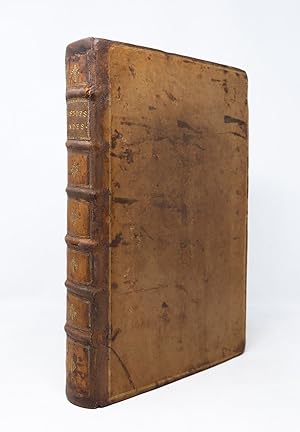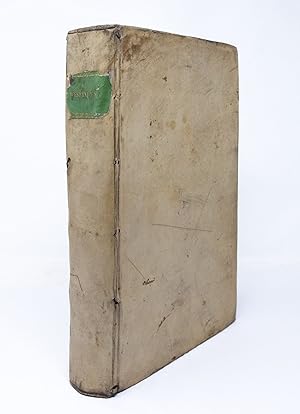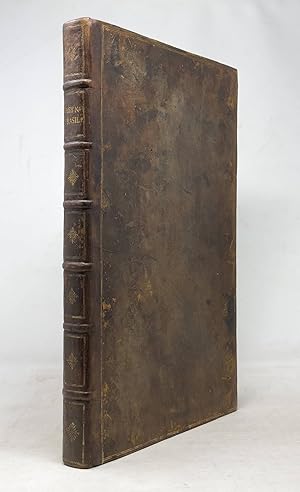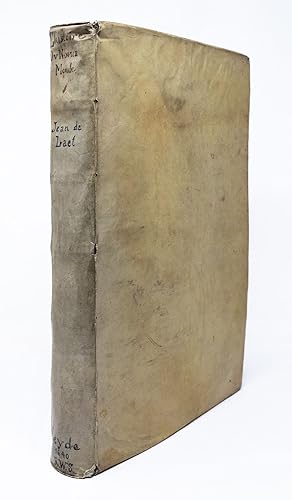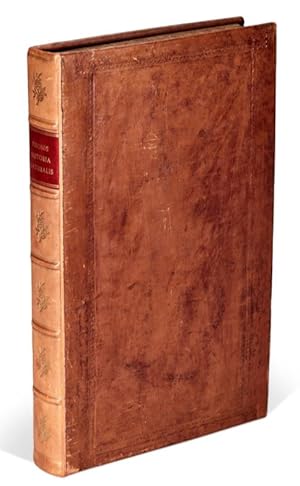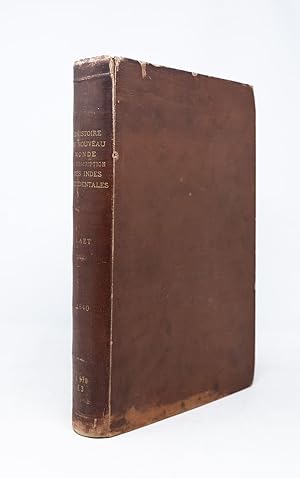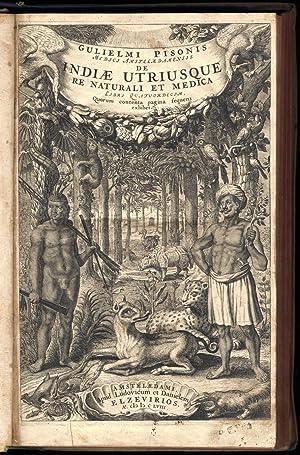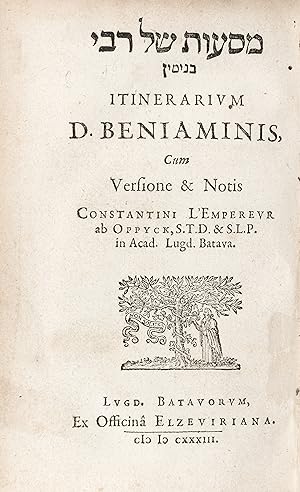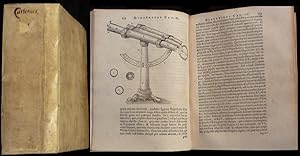elzevir (Plus de 1 200 résultats)
CommentairesFiltres de recherche
Type d'article
- Tous les types de produits
- Livres (1 176)
- Magazines & Périodiques (Aucun autre résultat ne correspond à ces critères)
- Bandes dessinées (Aucun autre résultat ne correspond à ces critères)
- Partitions de musique (Aucun autre résultat ne correspond à ces critères)
- Art, Affiches et Gravures (26)
- Photographies (Aucun autre résultat ne correspond à ces critères)
- Cartes (Aucun autre résultat ne correspond à ces critères)
- Manuscrits & Papiers anciens (Aucun autre résultat ne correspond à ces critères)
Etat En savoir plus
Particularités
Langue (10)
Livraison gratuite
Pays
Evaluation du vendeur
-
L'Histoire du Nouveau Monde ou Description des Indes Occidentales, Contenant dix-huict Liures, Par le Sieur Iean de Laet, d'Anuers; Enrichi de nouuelles Tables Geographiques & Figures des Animaux, Plantes & Fruicts
Edité par Bonaventure and Abraham Elzevir, Leiden, 1640
Vendeur : Arader Books, New York, NY, Etats-Unis
Edition originale
EUR 53 782,76
Autre deviseEUR 30,01 expédition depuis Etats-Unis vers FranceQuantité disponible : 1 disponible(s)
Ajouter au panierHardcover. Etat : Very good. First. THE FELNER-BORBA DE MORAES-STREETER COPY. First edition in French. Leiden: Bonaventure and Abraham Elzevir, 1640. Folio in 4s (13" x 8 1/4", 338mm x 222mm). [Full collation available.] With 14 double-page engraved maps and many woodcut illustrations integral to text. Bound in XIXc Spanish marbled calf (re-backed, with the original back-strip laid down). On the spine, five panels. Author and title gilt to black straight-grained morocco in the second panel. All edges of the text-block sprinkled red. Marbled end-papers. Re-backed, with the original back-strip laid down. Rubbed at the extremities. Fore-corners bumped, with some loss. Evenly tanned throughout, with occasional foxing. Some mis-bindings: Bb2.3 reversed and Ttt (2, 1, 4, 3) and Zzz (4, 1, 3, 2); see pagination above. Shelf-label of R. Felner (completed in ink manuscript) to the front paste-down, with the armorial bookplate of Rubens Borba Alves de Moraes below. Johannes de Laet (1581-1649), was born in Antwerp to cloth merchant Hans de Laet. In 1584, upon the invasion of Antwerp by Spanish troops, his family fled to the Northern Netherlands and settled in Amsterdam. At the University of Leiden, he studied philosophy and theology, matriculating in 1597. His worldly interests led him to London in 1603, where he cleverly invested in Dutch land reclamation projection and overseas trade. His success in his field led him to become one of the founding directors of the Dutch West India Company- a position he held from 1620 until his death. De Laet first published his account of the New World as Nieuwe Wereldt ofte Beschrijvinghe van West-Indien. (Leiden, 1625). This French edition, probably translated by de Laet himself -- each edition, from the 1633 Latin to this French, became more complete and accurate, making the French edition the most desirable (see Sabin) -- is one of the most important seventeenth-century New World histories and texts concerning early knowledge of the Americas. The "Nova Anglia" map, showing the coast and inland areas from Nova Scotia to North Carolina, is the first printed map to mention the name Manhattan, here spelled "Manbattes." The Streeter catalogue notes that "it is also the earliest to use the Dutch names of Noordt Rivier and Zuyd Rivier, for the Hudson and Delaware Rivers respectively, as well as the Indian Massachusets, for the new English colony . [the 'Nova Francia' map] is one of the foundation maps of Canada" (Streeter). The fourteen double-page maps are the work of Hessel Gerritsz, a Dutch engraver who was appointed official cartographer of both Dutch India Companies (over Blaeu). Rodrigo José de Lima Felner (1809-1877) was a Brazilian author and historian. As a member of The Sociedade Propagadora dos Conhecimentos Úteis (Society for the Diffusion of Useful Knowledge), he edited their weekly illustrated magazine O Panorama. Felner wrote some twenty dramas and from 1849 published O Bibliophilo, a periodical dedicated to bibliography. Rubens Borba Alves de Moraes (1899-1986), was a Brazilian bibliographer, historian and author of Bibliographia Brasiliana, a standard reference for material concerning South America. Of this work -- the present volume -- Borba de Moraes writes: "from a scholarly point of view this French translation is the best edition, and for Brazilian studies the additions we have specified above [viz. the sacking of Bahia and the conquest of Olinda etc.] make it an indispensable work." From the collection of Frank Sherwin Streeter (1918-2006), purchased at his sale ("Important navigation, Pacific voyages, cartography, science) at Christie's New York 17 April 2007, lot 309. Streeter was the son of the legendary Americana collector Thomas Streeter. Some of his collection he inherited from his father, but other volumes he added over many decades. Alden & Landis 640/111; Borba de Moraes I.384 (this copy); cf. Burden 229-232; Cumming, Southeast 34; Phillips 1149; Sabin 38558; Streeter sale 37; Willems 382.
-
1. Systema cosmicum, in quo quatuor dialogis, de duobus maximis mundi systematibus, Ptolemaico & Copernicano, utriusque rationibus philosophicis ac naturalibus indefinite propositis disseritur; 2. Nov-antiqua sanctissimorum patrum, & probatorum theologorum doctrina, de sacræ Scripturæ testimoniis, in conclusionibus mere naturalibus, quæ sensatâ experientiâ, & necessariis demonstrationibus evinci possunt, temere non usurpandis.; 3. Tractatus de proportionum instrumento, quod merito compendium uniuersæ geometriæ dixeris.
Edité par Daniel Elzevir and David Hautt 1635-1636, Strasbourg, 1635
Vendeur : Rodger Friedman Rare Book Studio, ABAA, Tuxedo, NY, Etats-Unis
Edition originale Edition internationale
EUR 35 325,29
Autre deviseEUR 68,16 expédition depuis Etats-Unis vers FranceQuantité disponible : 1 disponible(s)
Ajouter au panierEtat : Very Good. Three works in one volume. Quarto (22 cm); Systema cosmicum: [16], 495, [24] pages, including engraved title page, portrait and illustrations, Augustae Treboc[corum] [i.e., Strasbourg] : impensis Elzeviriorum, typis Davidis Hautti, 1635; Nov-antiqua: [8], 60 [4] pages, text printed in Latin and Italian in parallel columns, Augustae Treboc [corum], impensis Elzevirorum, typis Davidis Huatti, 1636; Tractatus: [8], 104 pages [lacks plate], Argentorati, typis Davidis Hautti, 1635. In early19th-century scarlet-dyed sheep uniquely embossed across the grain with rows of a toothed pattern, with gilt scroll border composed of interlocking fleurons and spine decorated and titled direct in gilt. Preserved in red cloth chemise and red cloth slipcase with 1/4 polished leather titled in gilt. Bookplate of Joannis De Bizzaro, and a manuscript note in Italian on first blank, "edizione rarissima." that records the purchase at the Libreria Pisani sale in Venice (1810) and the price paid, 80 lire. (The volume was not yet bound at the time of the note.) The Systema cosmicum is slightly browned, with occasional marginal notes in a contemporary hand; the other two works are quite browned, as usual. Partially unopened. Red gilt morocco bookplate of Robert Honeyman IV. References: Honeyman IV, 1409 (this copy); Systema cosmicum: CInti, 96; Riccardi I, 52; Willems 426 (noting poor quality of paper stock). Nov-Antiqua: Cinti, 98; Riccardi, I,515; Willems, 441 ("Pièce rare). Tractatus: Riccardi, I, 507. First Latin edition of Galileo's epochal (and powerfully suppressed) Dialogue concerning the two chief world systems. Even as the book was being banned in Rome (in 1633), Galileo's friends were planning an international edition in Latin, the lingua franca of the scientific community. A copy was effectively smuggled out of Italy to Strasbourg, home of the translator Matthias Bernegger. The mighty firm of Daniel Elzevir underwrote the publication, which was printed in Strasbourg by David Hautt. There was a rush to get it out, and the pressing began while the translator was still finishing up with the text. 600 copies were printed, a relatively large press run for the time. A new frontispiece was designed, based on the Italian edition but changed to show Copernicus as a young man, representing a young science in contrast to the two ancients, Aristotle and Ptolemy. The Systema Cosmicum is Galileo's Summa, involving his entire body of research. It is a stunning defense of the (outlawed) heliocentric cosmology described by Copernicus, and a biting invective against the acceptance of received scientific authority without further observation or experimentation. The next title in the collection, the Nov-antiqua sanctissimorum patrum., appears here in its first edition. It is the famous letter Galileo sent to the Grand Duchess of Tuscany, Christine de Lorraine, in 1615, discussing the boundaries between science and religion, and trying to reconcile the Copernican system with Christian scripture. (Arthur Koestler called it "a superb manifesto of the freedom of thought," and quoted it extensively in his Sleepwalkers.) Like the Systema cosmicum, it could only be published outside the hegemony of the Church. The edition was tiny and it was suppressed in Catholic countries. Only a few copies are supposed to have escaped destruction. The Tractatus de proportionum instrumento is the second Latin edition of describing Galileo's "proportion compass," the first important device to perform arithmetical calculations by mechanical means. First published in Italian in 1606, Galileo's compass was a great improvement over earlier German models.The "Appendix gemina" comprises: Perioche ex Introductione in Martem Johannis Kepleri, p. 459-464, and with special title page: Epistola Pauli Antonii Foscarini . circa pythagoricorum, & Copernici opinionem de mobilitate terrae, et stabilitate solis: et de novo systemate seu constitutione mundi: in qua Sacrae Scripturae autoritates, & the.
-
L'Histoire du Nouveau Monde ou Description des Indes Occidentales, Contenant dix-huict Liures, Par le Sieur Iean de Laet, d'Anuers; Enrichi de nouuelles Tables Geographiques & Figures des Animaux, Plantes & Fruicts
Edité par Bonaventure and Abraham Elzevir, Leiden, 1640
Vendeur : Arader Books, New York, NY, Etats-Unis
Edition originale
EUR 33 382,40
Autre deviseEUR 30,01 expédition depuis Etats-Unis vers FranceQuantité disponible : 1 disponible(s)
Ajouter au panierHardcover. Etat : Very good. First. First edition in French. Leiden: Bonaventure and Abraham Elzevir, 1640. Folio in 4s (13" x 8 7/16", 330mm x 213mm). [Full collation available.] With 14 double-page engraved maps and many woodcuts integral to the text. Bound in contemporary mottled sheep (re-backed, with the original back-strip laid down). On the spine, six raised bands. Author and title gilt to the second panel. All edges of the text-block speckled red. Re-backed, with the original back-strip laid down. Corners strengthened and the end-papers renewed. Raised bands rubbed. Filled loss to the upper edge as well as to a transverse split of the title-leaf. Worming to the fore-margin of Xxx2-3 (pp. 531-534). Damp-stain to the fore-margin of Gggg1 (p. 501) through the rear paste-down. Repaired tear to the first leaf of the map of Florida. Ownership signature of "Fr. Eiman" (?) on the title page. De Laet first published his account of the New World as Nieuwe Wereldt ofte Beschrijvinghe van West-Indien. (Leiden, 1625). This French edition, probably translated by de Laet himself -- each edition, from the 1633 Latin to this French, became more complete and accurate, making the French edition the most desirable (see Sabin) -- is one of the most important seventeenth-century New World histories and texts concerning early knowledge of the Americas. The "Nova Anglia" map, showing the coast and inland areas from Nova Scotia to North Carolina, is the first printed map to mention the name Manhattan, here spelled "Manbattes." The Streeter catalogue notes that "it is also the earliest to use the Dutch names of Noordt Rivier and Zuyd Rivier, for the Hudson and Delaware Rivers respectively, as well as the Indian Massachusets, for the new English colony . [the 'Nova Francia' map] is one of the foundation maps of Canada" (Streeter). It is "one of the most famous contemporary descriptions of the natural history of the New World. The work was highly praised a century later by Charlevoix, attesting to its accuracy [.] Winsor referred to Laet's book as the standard seventeenth-century work on New Netherland" (ibid.). The fourteen double-page maps are the work of Hessel Gerritsz, a Dutch engraver who was appointed official cartographer of both Dutch India Companies (over Blaeu). Of the signature on the title-page nothing can be gleaned; the CERL thesaurus records no "Eiman" and variations of the name are difficult to construct. The volume was later in the collection of Francis Anthony Benevento II (his sale, Sotheby's London 6 May 2010, lot 41). Frank Benevento (1947-2023) was a lawyer and later an investment banker with Lehman Brothers who began his collection of great maps and atlases here at Arader Galleries. Our purchasing dominated his sale. Alden & Landis 640/111; Borba de Moraes I.384; cf. Burden 229-232; Cumming, Southeast 34; Phillips 1149; Sabin 38558; Streeter sale 37; Willems 382.
-
[Dialogo] Systema cosmicum in quo quatuor dialogis, de duobus maximis mundi systematibus, ptolemaico & copernicano, utriusq; rationibus philosophicis ac naturalibus indefinite propositis, disseritur Accessit appendix gemina, qua SS. Scripturæ dicta cum terræ mobilitate conciliantur
Edité par David Hautt for Elzevir, [Leiden &] Strassburg, 1635
Vendeur : SOPHIA RARE BOOKS, Koebenhavn V, Danemark
Edition originale
EUR 30 909,63
Autre deviseGratuit expédition depuis Danemark vers FranceQuantité disponible : 1 disponible(s)
Ajouter au panierFirst edition. FIRST LATIN EDITION OF THE DIALOGO . First Latin edition of the Dialogo, Galileo's celebrated defence of the Copernican view of the solar system, the most notorious banned book of the 17th century. Written in dialogue form, it "was designed both as an appeal to the great public and as an escape from silence it is a masterly polemic for the new science. It displays all the great discoveries in the heavens which the ancients had ignored; it inveighs against the sterility, wilfulness, and ignorance of those who defend their systems; it revels in the simplicity of Copernican thought and, above all, it teaches that the movement of the earth makes sense in philosophy, that is, in physics The Dialogo, more than any other work, made the heliocentric system a commonplace" (PMM). "The Dialogo, far more than any work, convinced men of the truth of the Copernican system" (Gingerich). Pope Urban VIII was not persuaded, however, and immediately convened a special commission to examine the book and make recommendations. In casting the Pope as the simple-minded Aristotelian Simplicius, Galileo brought upon himself arrest, trial by the Inquisition and life imprisonment. The sentence was commuted to permanent house arrest, while the printing of any of his works was forbidden. The Dialogo remained on the index until 1832. This Latin edition was translated at Galileo's request by Matthias Bernegger (1582-1640), an Austrian from Hallstatt, who had studied in Strassburg, where he settled in 1603. In his preface he explains how he came to translate it, how he had taught himself Italian, and how eventually the Elzeviers, at the urging of the Hebraist Marcus Zuerius Boxhorn and others, persuaded him to undertake the work and agreed to publish it. In addition to rendering the work accessible to a larger audience outside Italy, Bernegger's translation also includes tracts by Kepler and Foscarini on the compatibility of the Copernican and Christian universes. These tracts were not present in the first edition. In August 1597, Galileo wrote to Kepler expressing his sympathies for Copernicanism, having received a copy of the Mysterium cosmographicum (1596) from him. At this time Galileo's support for Copernicus was Earth-based: Galileo had devised a theory of the tides involving the combined rotational motions of the Earth around its axis and, after Copernicus, around the Sun. Everything changed early in 1610 when Galileo first turned a telescope to the skies. Not only was the moon revealed to be mountainous and the Milky Way to consist of separate stars, contrary to Aristotelian principles, but a host of new fixed stars and four satellites of Jupiter were promptly discovered. Galileo's account of these discoveries was published in the Sidereus nuncius (Venice, 1610). Galileo saw in the satellites of Jupiter a miniature planetary system in which, as in Copernican astronomy, it could no longer be held that all moving heavenly bodies revolved exclusively about the earth. Galileo first spoke out decisively in print for the Copernican hypothesis in his 1613 work on sunspots, Istoria e dimostrazioni intorno alle macchie solari. During its composition he had taken pains to determine the theological status of the idea of incorruptibility of the heavens, finding that this was regarded by churchmen as an Aristotelian rather than a Catholic dogma. But attacks against Galileo and his followers soon appeared in ecclesiastical quarters. These came to a head with a denunciation from the pulpit in Florence late in 1614. A year later Galileo went to Rome (against the advice of his friends and the Tuscan ambassador) to clear his own name and to prevent, if possible, the official suppression of the teaching of Copernicanism. In the first, he succeeded, but on the second he failed: Galileo was instructed on 26 February 1616 to abandon the holding or defending of that view. No action was taken against him, nor were any of his books suspended. Returning to Florence, Galile.
-
Novus Orbis seu descriptionis Indiae Occidentalis libri XVIII Authore Ioanne de Laet Antverp. Novis Tabulis Geographicis et variis Animantium, Plantarum Fructuumque Iconibus illustrati
Edité par Elzevir, Leiden, 1633
Vendeur : Arader Books, New York, NY, Etats-Unis
Edition originale
EUR 29 673,25
Autre deviseEUR 30,01 expédition depuis Etats-Unis vers FranceQuantité disponible : 1 disponible(s)
Ajouter au panierHardcover. Etat : Very good. First. First Latin edition. Leiden: Elzevir, 1633. Folio in 6s (13 1/2" x 8 1/2", 217mm x 339mm). [Full collation available.] With 14 engraved double-page maps and 68 in-text woodcut illustrations. Bound in contemporary vellum with yapp edges. On the spine, author and title in ink manuscript. Some discolored fill to the extremities. A lovely fresh example internally, with the odd spot of soiling or foxing. Ink withdrawal stamp of the Free Library Philadelphia (2003) to the verso of the title-page. Johannes de Laet (1581-1649), was born in Antwerp to cloth merchant Hans de Laet. In 1584, upon the invasion of Antwerp by Spanish troops, his family fled to the Northern Netherlands and settled in Amsterdam. At the University of Leiden, he studied philosophy and theology, matriculating in 1597. His worldly interests led him to London in 1603, where he cleverly invested in Dutch land reclamation projection and overseas trade. His success in his field led him to become one of the founding directors of the Dutch West India Company- a position he held from 1620 until death. De Laet first published his account of the New World as Nieuwe Wereldt ofte Beschrijvinghe van West-Indien. . . (Leiden, 1625). This Latin edition, probably translated by de Laet himself, is one of the most important seventeenth-century New World histories and texts concerning early knowledge of the Americas. The "Nova Anglia" map, showing the coast and inland areas from Nova Scotia to North Carolina, is the first printed map to mention the name Manhattan, here spelled "Manbattes." "It is also the earliest to use the Dutch names of Noordt Rivier and Zuyd Rivier, for the Hudson and Delaware Rivers respectively, as well as the Indian Massachusets, for the new English colony . . . [the 'Nova Francia' map] is one of the foundation maps of Canada" (Streeter). It is "one of the most famous contemporary descriptions of the natural history of the New World. The work was highly praised a century later by Charlevoix, attesting to its accuracy [. . .] Winsor referred to Laet's book as the standard seventeenth-century work on New Netherland" (ibid.). The fourteen double-page maps are the work of Hessel Gerritsz, a Dutch engraver who was appointed official cartographer of both Dutch India Companies (over Blaeu). The Free Library of Philadelphia was established in 1891, and now comprises some 50 locations as well as the Rosenbach Museum and Library. The Free Library of Philadelphia Foundation, a separate organization intended to support the library, deaccessioned the present item and sold it at Christie's New York on 24 June 2003, lot 230. Alden & Landis 633/65; Borba de Moraes I.451; Burden 229-232; Cumming Southeast 34; Phillips 1149; Rodrigues, 1352; Sabin 38557; Schwartz & Ehrenberg, p. 105; Streeter sale 37; Willems 382.
-
L'Histoire du Nouveau Monde ou Description des Indes Occidentales, Contenant dix-huict Liures, Par le Sieur Iean de Laet, d'Anuers; Enrichi de nouuelles Tables Geographiques & Figures des Animaux, Plantes & Fruicts
Edité par Bonaventure and Abraham Elzevir, Leiden, 1640
Vendeur : Arader Books, New York, NY, Etats-Unis
Edition originale
EUR 27 818,67
Autre deviseEUR 30,01 expédition depuis Etats-Unis vers FranceQuantité disponible : 1 disponible(s)
Ajouter au panierHardcover. Etat : Very good. First. THE PRINCE ODOYEVSKY-YRARRÁZAVAL-RODRIGUEZ COPY. First edition in French. Leiden: Bonaventure and Abraham Elzevir, 1640. Folio in 4s (13 1/2" x 8 3/4", 342mm x 220mm). [Full collation available.] With 14 double-page engraved maps and many woodcut illustrations integral to text. Bound in contemporary mottled calf with a double blind fillet border. On the spine, six raised bands. Author gilt to the second panel, title gilt to the third, imprint at the tail. "M.J./ Yrarrazaval" in later gilt just above the imprint. Single gilt fillet to the edges of the boards. All edges of the text-block stained ox-blood red. Hinges cracked, with the front board starting. Head-piece chipped, tail-piece perished. Damp-stain to the boards, but not affecting the text-block. Paste-downs renewed. Mild even tanning throughout, with sporadic foxing. Worming to the upper fore-corner [pi]2-Dd3 (p. 214), not affecting the text Bookplate of Jose M. Rodriguez/ Bibliotheca Chizigonana to the front paste-down, with evidence of an obliterated bookplate above ("1421," presumably a shelf-mark, remains in ink manuscript). Ink annotation "1421" on front paste down. Ink notation "7206-A.3" (shelf-mark?), ownership signature of "Pr. Wlad. Odoewsky" and publication year in Arabic numerals to the title-page. Johannes de Laet (1581-1649), was born in Antwerp to cloth merchant Hans de Laet. In 1584, upon the invasion of Antwerp by Spanish troops, his family fled to the Northern Netherlands and settled in Amsterdam. At the University of Leiden, he studied philosophy and theology, matriculating in 1597. His worldly interests led him to London in 1603, where he cleverly invested in Dutch land reclamation projection and overseas trade. His success in his field led him to become one of the founding directors of the Dutch West India Company- a position he held from 1620 until his death. De Laet first published his account of the New World as Nieuwe Wereldt ofte Beschrijvinghe van West-Indien. (Leiden, 1625). This French edition, probably translated by de Laet himself -- each edition, from the 1633 Latin to this French, became more complete and accurate, making the French edition the most desirable (see Sabin) -- is one of the most important seventeenth-century New World histories and texts concerning early knowledge of the Americas. The "Nova Anglia" map, showing the coast and inland areas from Nova Scotia to North Carolina, is the first printed map to mention the name Manhattan, here spelled "Manbattes." The Streeter catalogue notes that the "Nova Francia" map "is one of the foundation maps of Canada" (Streeter). The fourteen double-page maps are the work of Hessel Gerritsz, a Dutch engraver who was appointed official cartographer of both Dutch India Companies (over Blaeu). Prince Vladimir Fyodorovich Odoyevesky (1803-1869) was the last member of the House of Odoyev. In 1826 he joined the staff of the Imperial Public Library. He co-edited the Sovremennik with Alexander Pushkin in the mid 1830's, and was subsequently put in charge of the personal library and historical collection of Count Nikolay Rumyantsev, becoming the Rumyantsev Museum under his direction. Manuel José Yrarrázaval Larraín (1834-1896) was a Chilean jurist and politician, eventually rising to Minister of the Interior in 1891. He was also active in publishing, supporting two of the major revolutionary newspapers. Upon his death, his library went to the Universidad Católica de Chile in Santiago. The bookplate of José M. Rodriguez (dated 1938) suggests that the book exited the collection of the university a few decades later. His "Bibliotheca Chizigonana," known principally through the books carrying this bookplate, seems to have focused on the New World. Alden & Landis 640/111; Borba de Moraes I.384; cf. Burden 229-232; Cumming, Southeast 34; Phillips 1149; Sabin 38558; Streeter sale 37; Willems 382.
-
Novus Orbis seu descriptionis Indiae Occidentalis libri XVIII Authore Ioanne de Laet Antverp. Novis Tabulis Geographicis et variis Animantium, Plantarum Fructuumque Iconibus illustrati
Edité par Elzevir, Leiden, 1633
Vendeur : Arader Books, New York, NY, Etats-Unis
Edition originale Signé
EUR 25 964,09
Autre deviseEUR 30,01 expédition depuis Etats-Unis vers FranceQuantité disponible : 1 disponible(s)
Ajouter au panierHardcover. Etat : Very good. First. THE TEMPELHOFF COPY. First Latin edition. Leiden: Elzevir, 1633. Folio in 6s (13 1/4" x 8 3/4", 215mm x 339mm). [Full collation available.] With 14 engraved double-page maps and many in-text woodcut illustrations. Bound in contemporary vellum with yapp edges. On the spine, author and title gilt to calf. Marbled end-papers. All edges of the text-block glazed black. Splits to the head- and tail-pieces, with the front hinge starting at the head. Some small splits and soiling to the extremities, with some spotting to the boards. End-papers renewed (XIXc?). Foxing throughout, with some heavier passages. Wear to hinges, with loss of matter to backstrip and cover edges. Annotations in ink throughout: underscoring, marginal notation, a list of memoranda with page numbers to the recto of the rear free end-paper. Note regarding the author tipped in before the title-page, signed "Georg: Sam: Tempelhoff." Johannes de Laet (1581-1649), was born in Antwerp to cloth merchant Hans de Laet. In 1584, upon the invasion of Antwerp by Spanish troops, his family fled to the Northern Netherlands and settled in Amsterdam. At the University of Leiden, he studied philosophy and theology, matriculating in 1597. His worldly interests led him to London in 1603, where he cleverly invested in Dutch land reclamation projection and overseas trade. His success in his field led him to become one of the founding directors of the Dutch West India Company- a position he held from 1620 until death. De Laet first published his account of the New World as Nieuwe Wereldt ofte Beschrijvinghe van West-Indien. (Leiden, 1625). This Latin edition, probably translated by de Laet himself, is one of the most important seventeenth-century New World histories and texts concerning early knowledge of the Americas. The "Nova Anglia" map, showing the coast and inland areas from Nova Scotia to North Carolina, is the first printed map to mention the name Manhattan, here spelled "Manbattes." "It is also the earliest to use the Dutch names of Noordt Rivier and Zuyd Rivier, for the Hudson and Delaware Rivers respectively, as well as the Indian Massachusets, for the new English colony . [the 'Nova Francia' map] is one of the foundation maps of Canada" (Streeter). It is "one of the most famous contemporary descriptions of the natural history of the New World. The work was highly praised a century later by Charlevoix, attesting to its accuracy [.] Winsor referred to Laet's book as the standard seventeenth-century work on New Netherland" (ibid.). The fourteen double-page maps are the work of Hessel Gerritsz, a Dutch engraver who was appointed official cartographer of both Dutch India Companies (over Blaeu). Georg Samuel Tempelhoff (1711-1775) was a Prussian career civil servant and father to the more famous Georg Friedrich von Tempelhoff (1737-1807), mathematician, scientist, and musician. Georg Samuel was a councilor (Amtsrat) who leased land near Eberswalde and Beeskow; it is on this foundation that his son, who was ennobled in 1784, built his success and, doubtless, his library. Alden & Landis 633/65; Borba de Moraes I.451; Burden 229-232; Cumming Southeast 34; Phillips 1149; Rodrigues, 1352; Sabin 38557; Schwartz & Ehrenberg, p. 105; Streeter sale 37; Willems 382.
-
L'Histoire du Nouveau Monde ou Description des Indes Occidentales, Contenant dix-huict Liures, Par le Sieur Iean de Laet, d'Anuers; Enrichi de nouuelles Tables Geographiques & Figures des Animaux, Plantes & Fruicts
Edité par Bonaventure and Abraham Elzevir, Leiden, 1640
Vendeur : Arader Books, New York, NY, Etats-Unis
Edition originale
EUR 25 964,09
Autre deviseEUR 30,01 expédition depuis Etats-Unis vers FranceQuantité disponible : 1 disponible(s)
Ajouter au panierHardcover. Etat : Very good. First. THE PUGET-HEMEY COPY. First edition in French. Leiden: Bonaventure and Abraham Elzevir, 1640. Folio in 4s (13 7/8" x 8 7/8", 353mm x 227mm). [Full collation available.] With 14 double-page engraved maps and many woodcut illustrations integral to text. Bound in contemporary stabbed vellum. On the spine, title and author in ink manuscript. All edges of the text-block sprinkled red. Corners bumped and splitting a little. Scattered mild soiling. Ink to the spine rubbed. Mildly evenly tanned and foxed throughout, with some passages of moderate tanning and foxing. Armorial bookplates of Ludovicus (Louis) de Puget's gift to the Lyon Jesuit College and of P.N. Hemey to the front paste-down. Price code (?) in ink to the bottom of the recto of the first free end-paper. Ink annotation on title-page: "Domus Prob. Lugd. Soc. Jesu Bibliot. Catalogo Inscrip. 1709" Johannes de Laet (1581-1649), was born in Antwerp to cloth merchant Hans de Laet. In 1584, upon the invasion of Antwerp by Spanish troops, his family fled to the Northern Netherlands and settled in Amsterdam. At the University of Leiden, he studied philosophy and theology, matriculating in 1597. His worldly interests led him to London in 1603, where he cleverly invested in Dutch land reclamation projection and overseas trade. His success in his field led him to become one of the founding directors of the Dutch West India Company- a position he held from 1620 until death. De Laet first published his account of the New World as Nieuwe Wereldt ofte Beschrijvinghe van West-Indien. (Leiden, 1625). This French edition, probably translated by de Laet himself -- each edition, from the 1633 Latin to this French, became more complete and accurate, making the French edition the most desirable (see Sabin) -- is one of the most important seventeenth-century New World histories and texts concerning early knowledge of the Americas. The "Nova Anglia" map, showing the coast and inland areas from Nova Scotia to North Carolina, is the first printed map to mention the name Manhattan, here spelled "Manbattes." The Streeter catalog notes that "it is also the earliest to use the Dutch names of Noordt Rivier and Zuyd Rivier, for the Hudson and Delaware Rivers respectively, as well as the Indian Massachusets, for the new English colony. . . [the 'Nova Francia' map] is one of the foundation maps of Canada" (Streeter). It is "one of the most famous contemporary descriptions of the natural history of the New World. The work was highly praised a century later by Charlevoix, attesting to its accuracy [. . .] Winsor referred to Laet's book as the standard seventeenth-century work on New Netherland" (ibid.). The fourteen double-page maps are the work of Hessel Gerritsz, a Dutch engraver who was appointed official cartographer of both Dutch India Companies (over Blaeu). Louis de Puget (1635-1709) was a French scientist and author. A celebrated teacher of the sciences, he founded the Académie des Sciences, Belles-Lettres et Arts de Lyon in 1700. His career as a naturalist and physicist produced significant advances in the field of microscopes and magnets. A lover of poetry and literature, he also amassed a large book collection, which was bequeathed to the Lyon Jesuit college upon his death in 1709; the annotation to the title-page indicates its inclusion in their catalogue in that year. Philibert Nicolas Hemey d'Auberive (1759-1816), a French clergyman and writer, served as the last Abbot of the Abbaye Saint-Léger d'Ébreuil under the appointment of Napoleon. In 1780, he was appointed Abbot of Ébreuil by Louis XVI, and in 1788, he was appointed Archbishop of Lyon. Napoleon twice offered Hemey a bishopric position at cathedrals in Digne and Agen, but he refused both, giving priority to his research and publications. Alden & Landis 640/111; Borba de Moraes I.384; cf. Burden 229-232; Cumming, Southeast 34; Phillips 1149; Sabin 38558; Streeter sale 37; Willems 382.
-
De Indiae utriusque re naturali et medica libri Quatuordecim
Edité par Amsterdam: Lowijs III and Daniel Elzevir, 1658., 1658
Vendeur : Arader Galleries - AraderNYC, New York, NY, Etats-Unis
Edition originale
EUR 22 961,44
Autre deviseEUR 30,01 expédition depuis Etats-Unis vers FranceQuantité disponible : 1 disponible(s)
Ajouter au panier3 parts in one volume. Folio (14 x 8 4/8 inches). Engraved title-page, 522 woodcut illustrations and diagrams of fish, birds, plants, insects, and animals [Cleveland Collections count], woodcut tail-pieces and initials (some pale marginal waterstaining intermittently affecting later pages). Contemporary speckled panelled calf, the spine in seven compartments with six raised bands, red morocco lettering-piece in one, the others decorated with fine gilt tools (a bit rubbed, hinges weak) Second and enlarged edition the "Historia naturalis Brasiliae" edited by Johannes de Laet (Leiden and Amsterdam: 1648), which combined Piso's "Medicina Brasiliensi" and Marcgrave's "Historiae rerum naturalium Brasiliae". For this new edition, Piso decided to completely re-edit the two texts, and added de Bondt's "Historiae naturalis et medicae Indiae Orientalis" and his own "Mantissa aromatica". Marcgrave was initially commissioned by the Dutch West India Company to travel to north-east Brazil as an astronomer. Along with another student of medicine and mathematics, H. Cralitz (who succumbed to disease within a year of his arrival), and the physician, Willem Piso, he arrived in Brazil in 1738. Marcgrave travelled extensively, collecting all manner of plants and animals, before he was unexpectedly called upon to travel to Angola, whereupon he too died. So Piso returned to Holland with Prince Maurits, and without Marcgrave or Cralitz, but "laden with considerable collections of specimens and the confusing notes of Marcgrave. The astronomer had written his natural history findings in a cipher, purportedly to prevent Piso claiming credit for the work. Piso's contributions to the first edition of "Historia Naturalis Brasiliae" (1648) were contained in four books of 12 volumes, under the heading "De medicine Brasiliense", while eight volumes on botany and zoology were compiled from the material authored by Marcgrave. Johannes de Laet (1593-1649), director of the Dutch West India Company, decoded and edited Marcgrave's work for this edition, but when a second edition of the "Historia" appeared ten years later [as here] under the title "De Indiae Utrusque re naturali et medica", Piso carelessly made his own treatment of Marcgrave's work. For this he was severely criticised by, among others, Carl Linnaeus. "While both men obviously made remarkable contributions to the knowledge of Brazil's natural history, Marcgrave's work is considered in many quarters to exceed that of Piso in quality as well as quantity, despite his shorter years. A large map of Brazil produced by Marcgrave was also published posthumously in 1747. Indeed, after these explorations, nothing was written on Brazilian botany for more than 150 years except for the observations made by La Condamine in the mid-1700s. Although Rio de Janeiro was an international shipping port in the 17th and 18th centuries, few ventured beyond the city, largely thanks to the intimidating rule of Spanish and Portuguese administration" (Natural History Museum online). Arnold Arboretum p. 558; Borba de Moraes pp. 676-677; Cleveland Collections 225 (without Piso final blank); Garrison-Morton 1825; Hunt 280; Nissen IVB 589; Nissen BBI 1533; Willems 1236; Wood p. 520.
-
L'Histoire du Nouveau Monde ou Description des Indes Occidentales, Contenant dix-huict Liures, Par le Sieur Iean de Laet, d'Anuers; Enrichi de nouuelles Tables Geographiques & Figures des Animaux, Plantes & Fruicts
Edité par Bonaventure and Abraham Elzevir, Leiden, 1640
Vendeur : Arader Books, New York, NY, Etats-Unis
Edition originale
EUR 22 254,94
Autre deviseEUR 30,01 expédition depuis Etats-Unis vers FranceQuantité disponible : 1 disponible(s)
Ajouter au panierHardcover. Etat : Very good. First. First edition in French. Leiden: Bonaventure and Abraham Elzevir, 1640. Folio in 4s (13 1/2" x 8 5/8", 342mm x 216mm). [Full collation available.] With 14 double-page engraved maps and many woodcut illustrations integral to text. Bound in later calf (re-backed, with the original panels of the back-strip laid down). On the spine, six raised bands. Title gilt to sheep in the second panel. All edges of the text-block speckled brown. Re-backed with the original panels laid down. Scratching and cracking to the backstrip and boards. Fore-corners strengthened. Mildly evenly tanned throughout, with sporadic light foxing. Wormhole in bottom gutter from the first free end-paper through M3 (p. 94). Obliterated XVIIIc armorial bookplate to the front paste-down, with the early ink ownership signature "D'Anglure" at the bottom right corner. Johannes de Laet (1581-1649), was born in Antwerp to cloth merchant Hans de Laet. In 1584, upon the invasion of Antwerp by Spanish troops, his family fled to the Northern Netherlands and settled in Amsterdam. At the University of Leiden, he studied philosophy and theology, matriculating in 1597. His worldly interests led him to London in 1603, where he cleverly invested in Dutch land reclamation projection and overseas trade. His success in his field led him to become one of the founding directors of the Dutch West India Company- a position he held from 1620 until death. De Laet first published his account of the New World as Nieuwe Wereldt ofte Beschrijvinghe van West-Indien. (Leiden, 1625). This French edition, probably translated by de Laet himself -- each edition, from the 1633 Latin to this French, became more complete and accurate, making the French edition the most desirable (see Sabin) -- is one of the most important seventeenth-century New World histories and texts concerning early knowledge of the Americas. The "Nova Anglia" map, showing the coast and inland areas from Nova Scotia to North Carolina, is the first printed map to mention the name Manhattan, here spelled "Manbattes." The Streeter catalogue notes that "it is also the earliest to use the Dutch names of Noordt Rivier and Zuyd Rivier, for the Hudson and Delaware Rivers respectively, as well as the Indian Massachusets, for the new English colony . [the 'Nova Francia' map] is one of the foundation maps of Canada" (Streeter). It is "one of the most famous contemporary descriptions of the natural history of the New World. The work was highly praised a century later by Charlevoix, attesting to its accuracy [.] Winsor referred to Laet's book as the standard seventeenth-century work on New Netherland" (ibid.). The fourteen double-page maps are the work of Hessel Gerritsz, a Dutch engraver who was appointed official cartographer of both Dutch India Companies (over Blaeu). The signature of "D'Anglure" could be either the name that had been on the obliterated bookplate or, perhaps likelier, the name of a later owner. Could this be either Charles-François (1605-1669, Archbishop of Toulouse) or his brother Louis (1618-1697, Archbishop of Bordeaux) d'Anglure de Bourlément? The family was distinguished in the Southwest, and had connections to Rome and elsewhere in Europe. Alden & Landis 640/111; Borba de Moraes I.384; cf. Burden 229-232; Cumming, Southeast 34; Phillips 1149; Sabin 38558; Streeter sale 37; Willems 382.
-
Beschrijvinghe van West-Indien door Ioannes de Laet. Tweede druck: In ontallÿcke plaetsen verbetert, vermeerdert, met eenige nieuwe Caerten, beelden van verscheyden dieren ende planten verciert
Edité par Elzevir, Leiden, 1630
Vendeur : Arader Books, New York, NY, Etats-Unis
EUR 22 254,94
Autre deviseEUR 30,01 expédition depuis Etats-Unis vers FranceQuantité disponible : 1 disponible(s)
Ajouter au panierHardcover. Etat : Very good. Second. Second edition, enlarged. Leiden: Elzevir, 1630. Folio in 6s (12 ¼" x 7 ¾", 311mm x 196mm). [Full collation available.] With 15 engraved plates: an engraved title (integral with the text) and 14 double-page engraved maps. Bound in contemporary stabbed vellum over pasteboard with yapp edges. On the spine, title gilt to a lime green calf label. All edges of the text-block stained green. Cover worn and stained with some holes through the hinges and back-strip. End-papers renewed. Lacking the half-title (*1). Damp-stain to the fore edge of I1-Fff6 (pp. 89-608), occasionally moderately heavy. Ink annotations throughout text (underscoring, some marginal notation). Pages evenly tanned. Loss to the fore-edge of Ccc5 (not affecting the text). Short marginal tears to the "Straet van Magallanes." Worming to the bottom edge of Rr1-Iii4 (pp. 449ff.), not affecting the text. Johannes de Laet (1581-1649), was born in Antwerp to cloth merchant Hans de Laet. In 1584, upon the invasion of Antwerp by Spanish troops, his family fled to the Northern Netherlands and settled in Amsterdam. At the University of Leiden, he studied philosophy and theology, matriculating in 1597. His worldly interests led him to London in 1603, where he cleverly invested in Dutch land reclamation projection and overseas trade. His success in his field led him to become one of the founding directors of the Dutch West India Company- a position he held from 1620 until death. De Laet first published his account of the New World as Nieuwe Wereldt ofte Beschrijvinghe van West-Indien. (Leiden, 1625). This expanded edition is one of the most important seventeenth-century New World histories and texts concerning early knowledge of the Americas. The "Nova Anglia" map, showing the coast and inland areas from Nova Scotia to North Carolina, is the first printed map to mention the name Manhattan, here spelled "Manbattes." Streeter calls it "one of the most famous contemporary descriptions of the natural history of the New World. The work was highly praised a century later by Charlevoix, attesting to its accuracy [.] Winsor referred to Laet's book as the standard seventeenth-century work on New Netherland." The fourteen double-page maps are the work of Hessel Gerritsz, official cartographer of both Dutch India Companies (over Blaeu). Alden & Landis 630/88; Borba de Moraes I.384; cf. Burden 229-232; Sabin 38555. Catalogued by Sophie J. Fyfe.
-
Historia naturalis Brasilia, Auspicio et Beneficio illustriss. I. Mauritii Com. Nassau. Illius Provinciæ et Maris summi Praefecti Adornata: In qua Non tantum Plantæ et Animalia, sed et Indigenarum morbi, ingenia et mores describuntur et Iconibus supra quingentas illustrantur
Edité par Franciscus Hackius & Lodewijck Elzevir, Leiden & Amsterdam, 1648
Vendeur : Arader Books, New York, NY, Etats-Unis
Edition originale
EUR 22 254,94
Autre deviseEUR 30,01 expédition depuis Etats-Unis vers FranceQuantité disponible : 1 disponible(s)
Ajouter au panierHardcover. Etat : Very good. First. GEORGES CUVIER'S WORKING COPY OF THE MOST IMPORTANT XVIIc SCIENTIFIC WORK ON BRAZIL. Leiden: Franciscus Hackius; Amsterdam: Lodewijck Elzevir, 1648. Folio in 4s (15 5/16" x 9 ¾", 387mm x 248mm). [Full collation available; xii, 122, ii; viii, 293, vii] With an engraved title-page and wood-cut illustrations, all integral to the text. Bound in contemporary calf (re-backed, with the original back-strip laid down) with a double gilt fillet border. On the spine, six raised bands. Title (HIST. NAT./BRASILI) to the second panel. All edges of the text-block speckled brown and red. Re-backed (with the original back-strip laid down) with the corners strengthened. Some scuffing and soiling to the boards. Excellent margins. Some passages of moderate tanning and foxing, but overall a clean copy. Some worming to the lower margins, especially 2V2-Y2. Loss to the lower fore-corner of 2Ll4, not affecting the text. Ink-stamps of G. Cuvier, the Museum d'Histoire Naturelle (twice; once over and partially obscuring a stamp ending in "Valenciennes.") and the later Bibliothèque du Museum (d'Histoire Naturelle) "cession autorisée," all to the contents page. Extensive graphite (once in ink to p. 2235) marginalia from p. 2142ff., through the sections on fish, birds and amphibians. Willem Piso (1611-1678) and Georg Marcgraf (Marcgrave, Marggraf; 1610-1644) produced two works -- both of which Piso saw to press, as Marcgraf died before publication; all dedicated to Johan Maurits, Prince of Nassau-Siegen and governor of Dutch Brazil -- that, issued together, came to define the natural historical knowledge of Brazil well into the XIXc. Piso was a doctor, and his contribution (de medicina Brasiliensi) treats the climate, diseases (one of which claimed Marcgraf's life in Guinea; the third member of their party, Heinrich Cralitz, also died there), poisons and "simples" (OED sub "simple, adj., n., adv., and int." II.4.a), medicines consisting of a single (active) ingredient. Marcgraf's work was written in a cipher deciphered by Johannes de Laet, the great Dutch cartographer and director of the Dutch West India Company, who also contributed a preface. It is the wider-ranging work, surveying and illustrating (as did Piso's work; the illustrations are after Marcgraf and Albert Eckhout) the flora and fauna of Brazil. Split into eight books, the eighth (also by de Laet) is ethnographic, treating the dress, customs and language -- including a glossary -- of the native Brazilians. Altogether the work painted a vivid and scientifically rich picture of Brazil that captured the attention of later authors as diverse as Cotton Mather and Thomas Jefferson. The great Nachleben of the Historia, however, is in the scientific community. Linnaeus relied on it for his own classification work, as did Georges Cuvier (1769-1832), one of the great XIXc natural scientists. His 1816 Règne Animal and Histoire naturelle des poissons apply the principals of Linnaeus to the animal kingdom according the branching of phyla, and it is in the production of these works that he must have made his extensive marginalia in the present volume. Moreover, Cuvier was a historian of science; his series of public lectures at the end of his life -- the Histoire des sciences naturelles, now published in English as Cuvier's History of the Natural Sciences -- included one (no. 6) on the "Contributions of the Early Dutch Naturalists," which discusses the contributions of Piso and Marcgraf at length, and the value of the present work -- the present volume -- in particular. He particularly praises its reliability (nearly 200 years after its publication): "It is even considered to be a book of reference that can be read with trust in every aspect" ( 6). Purchased at Christie's London, 18 November 2014, lot 65. Borba de Moraes, pp. 675-676; Garrison & Morton 5303; Nissen, BBI 1553; Nissen IVB 589; Rodrigues 1910; Sabin 63028.
-
L'Histoire du Nouveau Monde ou Description des Indes Occidentales, Contenant dix-huict Liures, Par le Sieur Iean de Laet, d'Anuers; Enrichi de nouuelles Tables Geographiques & Figures des Animaux, Plantes & Fruicts
Edité par Bonaventure and Abraham Elzevir, Leiden, 1640
Vendeur : Arader Books, New York, NY, Etats-Unis
Edition originale Signé
EUR 18 545,78
Autre deviseEUR 30,01 expédition depuis Etats-Unis vers FranceQuantité disponible : 1 disponible(s)
Ajouter au panierHardcover. Etat : Very good. First. First edition in French. Leiden: Bonaventure and Abraham Elzevir, 1640. Folio in 4s (14" x 9", 355mm x 228mm). [Full collation available.] With 14 double-page engraved maps. Bound in contemporary vellum over paste-board with yapp edges. On the spine, title, author, imprint and the initials "R.W.S." ink manuscript. All edges of the text-block stained black. Both hinges starting, but not more than 12mm. Some soiling and rubbing to the vellum, with signs of damp-staining to both boards but not affecting the text-block. 15mm loss to the rear yapp edge. Fore-edges of the first free end-paper and the first two leaves of the text worn. Mildly evenly tanned, with some foxing and scattered ink-burn. Gutter tear to "Maiores minores qve insvlae Hispaniola, Cvba Lucaiae et Caribes." Worm-hole to the gutter of **1-L1 (first page of the preface-82), not affecting the text. Notation to front paste-down in graphite: "308,000/1969.22/4 [.] remalé (?) Staudt _ (u. $s. 880)" above the bookplate of Staudt, completed in graphite "37/3." Old ink inscription to the recto of the first rear end-paper "a La haÿe Le 6.e Nouembre/ 1696 voor, 22242/". Johannes de Laet (1581-1649), was born in Antwerp to cloth merchant Hans de Laet. In 1584, upon the invasion of Antwerp by Spanish troops, his family fled to the Northern Netherlands and settled in Amsterdam. At the University of Leiden, he studied philosophy and theology, matriculating in 1597. His worldly interests led him to London in 1603, where he cleverly invested in Dutch land reclamation projection and overseas trade. His success in his field led him to become one of the founding directors of the Dutch West India Company, a position he held from 1620 until his death. De Laet first published his account of the New World as Nieuwe Wereldt ofte Beschrijvinghe van West-Indien. (Leiden, 1625). This French edition, probably translated by de Laet himself -- each edition, from the 1633 Latin to this French, became more complete and accurate, making the French edition the most desirable (see Sabin) -- is one of the most important seventeenth-century New World histories and texts concerning early knowledge of the Americas. The "Nova Anglia" map, showing the coast and inland areas from Nova Scotia to North Carolina, is the first printed map to mention the name Manhattan, here spelled "Manbattes." The Streeter catalogue notes that "it is also the earliest to use the Dutch names of Noordt Rivier and Zuyd Rivier, for the Hudson and Delaware Rivers respectively, as well as the Indian Massachusets, for the new English colony . [the 'Nova Francia' map] is one of the foundation maps of Canada" (Streeter). It is "one of the most famous contemporary descriptions of the natural history of the New World. The work was highly praised a century later by Charlevoix, attesting to its accuracy [.] Winsor referred to Laet's book as the standard seventeenth-century work on New Netherland" (ibid.). The fourteen double-page maps are the work of Hessel Gerritsz, a Dutch engraver who was appointed official cartographer of both Dutch India Companies (over Blaeu). The early acquisition (6 November 1696) note at the end of the volume shows the volume in trade. The Staudt bookplate is signed at the lower edge "G. Otto 1924," giving a terminus post quem for its insertion. G. Otto was an active bookplate-printer from the late XIXc. The bookplate has appeared on other volumes of Americana (e.g., Burmeister's Reise nach Brasilien in the Mindlin library at the University of São Paolo). This is, presumably, Richard Wilhelm Staudt (cf. the R.W.S. at the tail of the spine; 1888-1955) the notorious Argentine-German arms-dealer who furnished the Nazis with weapons. The graphite note at the front paste-down suggests the purchase of the volume from Staudt (their sale?) for the equivalent of $880 in 1969. Alden & Landis 640/111; cf. Burden 229-232; Cumming, Southeast 34; Phillips 1149; Sabin 38558; Streeter sale 37; Willems 382.
-
[In Arabic:] Kitab ajayib [or: Agaib] al-maqdur fi akhbar Timur / talif Ahmad ibn Arabshah Agaib al-maqdur fi ahbar Timur [In Latin:] Ahmedis Arabsiadae vitae & rerum gestarum TIMURI, qui vulgo TAMERLANES dicitur, HISTORIA. Other Title: Historia Tamerlanis Arabice
Edité par Elzevir, Bonaventure, 1583-1652, printer. Officina Elzeviriana, printer. Ex. Typographia Elseviriana, Lygdvni Batavorvm, 1636
Langue: anglais
Vendeur : Meir Turner, New York, NY, Etats-Unis
EUR 13 246,99
Autre deviseEUR 79,74 expédition depuis Etats-Unis vers FranceQuantité disponible : 1 disponible(s)
Ajouter au panierHardcover. Etat : Very Good. [8], 448 pages [=228 leaves] plus blanks. Complete. 196 x 153 mm. Top left corner of half title and title page restored. Full leather, in box. References: Rahir, no. 427; Willems, no. 434; Brunet, I, 117; Berghman,; no. 1906; Copinger, no. 34. Sarton III, 1266; Smitskamp 313. With a preliminary half-title leaf in red and blue. Half title reads: Historia Tamerlanis, Arabice./ Pages numbered from right to left: according to the Huruf al-'Abjad system./ Leaf *3r printed in red black and blue./ Signatures: *4 A-3K4./ Parallel title and preliminaries in Latin; text in Arabic only./ All pages of text proper enclosed in a plain rule-border./ Head- and tail-piece, initials. Other Titles: Ahmedis Arabsiadae Vitae et rerum gestarum Timuri, qui vulgo Tamerlanes dicitur, historia; Vitae et rerum gestarum Timuri, qui vulgo Tamerlanes dicitur, historia. Ahmedis arabsiadae itae et rerum gestarum Timuri, qui vulgo Tamerlanes dicitur, historia. Title page in Latin and Arabic printed in red and black within architectural woodcut border by Christoph van Sichem, and Latin half title printed in blue and red. Arabic text apart from front matter in Latin. History of the conquests and reign of Timur (Tamerlane). leaf *3 printed in red, dark blue, and black. Blue ink is used for the printing of the word 'Tamerlanis' (between two red lines) on the half-title, as well as for one typographical ornament on leaf 3 recto" The book is based on the original Arabic manuscript completed in 1438 by the Syrian author Ahmad lbn 'Arabshah was secretary to Sultan Ahmad of Baghdad. In the 16th century Timur regained his fame in Europe through Christopher Marlowe's play "Tamburlaine" (published in 1590). First Arabic edition of this important eyewitness account of the life of Tamerlane (Timur Lenk), the immensely successful 14th century Turkic conqueror.
-
ACADEMIE DE L'ESPEE. OU SE DEMONSTRENT PER REIGLES MATHEMATIQUES SUR LE FONDEMENT D'UN CERCLE MYSTERIEUX LE THEORIE ET PRATIQUE DES VRAIS ET JUSQU'A PRESENT INCOGNUS SECRETS DU MANIEMENT DES ARMES A PIED ET A CHEVAL.
Edité par Leiden: B. & A. Elzevir. 1628, 1628
Vendeur : Charles Russell, ABA, ILAB, est 1978, Cirencester, Royaume-Uni
EUR 12 976,21
Autre deviseEUR 4,70 expédition depuis Royaume-Uni vers FranceQuantité disponible : 1 disponible(s)
Ajouter au panierTwo parts in one volume, large folio 21 x 16 1/2 inches. Full eighteenth century calf- worn, boards detached. Engraved portrait of the author, 9 plates of coats-of-arms, 46 plates (plates complete), all but one double-page, by Crispin de Passe (1), Wilhelm Jacob Delff (3), J. Gilli (6), Crispian Quebon (6) and others, divided into 33 sections in the first part, and 13 sections in the second, each separately paginated. Numerous condition issues- most minor- Lacking engraved title, portrait repaired, 4 plates with repairs, mostly on the verso, some outer marginal minor splits. The last plate creased and with some tiny old holes- to the last two plates. HOWEVER A GOOD WORKING OR BREAKING COPY OF THIS MASTERPIECE ON FENCING. Two plates are enlarged copies of emblematic engravings in praise of fencing produced for Thibault around 1615 and the remainder are of fencers in either Roman costume or period seventeenth century costume. The most sumptuous book on fencing ever produced: a triumph of the art of book production with inspired typography blending seamlessly with very fine engraving. These folding plates are the largest produced on fencing.
-
De Indiae utriusque re naturali et medica libri Quatuordecim
Edité par Amsterdam: Lowijs III and Daniel Elzevir, 1658., 1658
Vendeur : Arader Galleries - AraderNYC, New York, NY, Etats-Unis
Edition originale
EUR 12 363,85
Autre deviseEUR 30,01 expédition depuis Etats-Unis vers FranceQuantité disponible : 1 disponible(s)
Ajouter au panier3 parts in one volume. Folio (14 4/8 x 9 inches). Engraved title-page, 522 woodcut illustrations and diagrams of fish, birds, plants, insects, and animals [Cleveland Collections count], woodcut tail-pieces and initials (engraved title-page nearly detached, without final blank at end of the first work, occasional spotting, some light browning). Contemporary vellum over paste-board, the spine in six compartments with five raised bands, brown morocco lettering-piece (worn with loss) in one (one or two pale stains). Provenance: with the ownership inscription of Giaco[mo] Soranzo (1686-1761), Venetian senator and bibliophile, on the front free endpaper dated 1720 (ownership inscription dated 1720); with the ownership inscription of Ranutii Aloysii Scarpacci on the verso of the front free endpaper; unidentified partially removed book label on the front paste-down. Second and enlarged edition the "Historia naturalis Brasiliae" edited by Johannes de Laet (Leiden and Amsterdam: 1648), which combined Piso's "Medicina Brasiliensi" and Marcgrave's "Historiae rerum naturalium Brasiliae". For this new edition, Piso decided to completely re-edit the two texts, and added de Bondt's "Historiae naturalis et medicae Indiae Orientalis" and his own "Mantissa aromatica". Marcgrave was initially commissioned by the Dutch West India Company to travel to north-east Brazil as an astronomer. Along with another student of medicine and mathematics, H. Cralitz (who succumbed to disease within a year of his arrival), and the physician, Willem Piso, he arrived in Brazil in 1738. Marcgrave travelled extensively, collecting all manner of plants and animals, before he was unexpectedly called upon to travel to Angola, whereupon he too died. So Piso returned to Holland with Prince Maurits, and without Marcgrave or Cralitz, but "laden with considerable collections of specimens and the confusing notes of Marcgrave. The astronomer had written his natural history findings in a cipher, purportedly to prevent Piso claiming credit for the work. Piso's contributions to the first edition of "Historia Naturalis Brasiliae" (1648) were contained in four books of 12 volumes, under the heading "De medicine Brasiliense", while eight volumes on botany and zoology were compiled from the material authored by Marcgrave. Johannes de Laet (1593-1649), director of the Dutch West India Company, decoded and edited Marcgrave's work for this edition, but when a second edition of the "Historia" appeared ten years later [as here] under the title "De Indiae Utrusque re naturali et medica", Piso carelessly made his own treatment of Marcgrave's work. For this he was severely criticised by, among others, Carl Linnaeus. "While both men obviously made remarkable contributions to the knowledge of Brazil's natural history, Marcgrave's work is considered in many quarters to exceed that of Piso in quality as well as quantity, despite his shorter years. A large map of Brazil produced by Marcgrave was also published posthumously in 1747. Indeed, after these explorations, nothing was written on Brazilian botany for more than 150 years except for the observations made by La Condamine in the mid-1700s. Although Rio de Janeiro was an international shipping port in the 17th and 18th centuries, few ventured beyond the city, largely thanks to the intimidating rule of Spanish and Portuguese administration" (Natural History Museum online). Arnold Arboretum p. 558; Borba de Moraes pp. 676-677; Cleveland Collections 225 (without Piso final blank); Garrison-Morton 1825; Hunt 280; Nissen IVB 589; Nissen BBI 1533; Willems 1236; Wood p. 520. Catalogued by Kate Hunter.
-
Gulielmi Pisonis Medici Amstelædamensis de Indiæ utriusque re naturali et medica libri quatuordecim, Quorum contenta pagina sequens exhibet
Edité par Lodewijck and Daniel Elzevir, Amsterdam, 1658
Vendeur : Arader Books, New York, NY, Etats-Unis
Edition originale
EUR 11 127,47
Autre deviseEUR 30,01 expédition depuis Etats-Unis vers FranceQuantité disponible : 1 disponible(s)
Ajouter au panierHardcover. Etat : Very good. First. "Second edition" (but first thus, largely revised). Amsterdam: Lodewijck and Daniel Elzevir, 1658. Folio in 6s (8 3/8" x 13 9/16", 214mm x 344mm). [Full collation available.] With an engraved title page and 530 woodcuts integral with the text. Bound in contemporary calf (re-backed) with a blind roll border and corner ornaments. On the spine, 5 raised bands. Author and title ("PISONIS/ HISTORIA/ NATURALIS") gilt to red sheepskin in the second panel. Date gilt to tail. All edges of the text-block mottled red. Re-backed, with the end-papers renewed. Gently scuffed, with some craquelure to the bottom edge of the rear board, and a crescent of damp at the spine-edge. Tanned generally with scattered foxing. Title-leaf reinserted and strengthened at the fore. Crude repairs to the index leaf (3T6), not affecting the text. Linnaean binomials inked beside numerous botanical woodcuts. Collated complete against Landwehr. Soon after receiving his medical degree from Caen in 1633, Willem Piso (Pies; 1611-1678) was offered a position in the Dutch West India Company (Geoctrooieerde Westindische Compagnie, or GWC) as a physician to the governor of Dutch Brazil, Prince Johann Maurits of Orange-Nassau. Piso left for Brazil alongside the German naturalist and astronomer Georg Marcgraf (Marggraf, Marcgrave; 1610-1644), with whom he authored his first text on the flora and fauna of Brazil, Historia Naturalis Brasiliae (see our first edition). Marcgraf died of a fever during an exploration in Guinea prior to its release, but Piso went forward with their collaboration, publishing the work in 1648. Ten years later, Piso saw the work to press. The text was advertised as a revised and expanded edition of the Historia, but Sabin argues differently, noting that "a number of the woodcuts in this work are reproduced from [Historia, therefore,] this is sometimes said to be a second edition. It is in fact a different work, as a comparison of its contents will prove." Although this volume retained Marcgraf's contributions, Piso's editorial choices -- marked by transcription errors and substantial omissions -- drew criticism, notably from Carolus Linnaeus, who had relied on Historia for his own classification work in the years after its release. The compilation additionally includes the posthumous work of Jacob Bontius (1592-1631), a Dutch physician who served in the Indonesian archipelago. His detailed observations on the dysentery epidemic and the practices of local physicians provided valuable insights into tropical diseases and their treatments. Despite the editorial controversy, De Indiae Utriusque re naturali et medica made a lasting impact by documenting indigenous botanical knowledge holistically. It builds upon one of the earliest surveys of the region and remains a cornerstone of Dutch naturalism. The present volume was lot 112 at Sotheby's "Manuscripts and Music from Medieval to Modern" sale in London (12 December 2023). It previously resided in the library of Clayre and Jay Michael Haft. Jay Haft (1935-2022) was a corporate lawyer, a dedicated philanthropist, and an avid collector. Hunt 280; Landwehr, VOC 828; Sabin 63031. Catalogued by GR Murdock.
-
De Indiae utriusque re naturali et medica
Edité par Louis and Daniel Elzevir, 1658
Vendeur : Arader Galleries - AraderNYC, New York, NY, Etats-Unis
EUR 10 597,59
Autre deviseEUR 30,01 expédition depuis Etats-Unis vers FranceQuantité disponible : 1 disponible(s)
Ajouter au panierHardcover. Etat : Very Good. Amsterdam: Louis and Daniel Elzevir, 1658. Folio (345mm x 212mm): with an engraved title page, numerous woodcuts, woodcuts of plants with manuscript binomial classification. Bound in later calf with blind-tooled border, spine with raised bands in 6 panels, gilt decoration to the spine, sprinkled edges. Marginal tape repairs to index leaf, binding re-backed and slightly rubbed. Borba de Moraes II, 153; Sabin 63029; Willems 1236. Ex coll. Clayre and Jay Michael Haft; their sale, Sotheby's London, 12 December 2023, lot 112.
-
L'Histoire du Nouveau Monde ou Description des Indes Occidentales, Contenant dix-huict Liures, Par le Sieur Iean de Laet, d'Anuers; Enrichi de nouuelles Tables Geographiques & Figures des Animaux, Plantes & Fruicts
Edité par Bonaventure and Abraham Elzevir, Leiden, 1640
Vendeur : Arader Books, New York, NY, Etats-Unis
Edition originale
EUR 10 200,18
Autre deviseEUR 30,01 expédition depuis Etats-Unis vers FranceQuantité disponible : 1 disponible(s)
Ajouter au panierHardcover. Etat : Very good. First. THE HENNEN-CRERAR-NEWBERRY COPY. First edition in French. Leiden: Bonaventure and Abraham Elzevir, 1640. Folio in 4s (13" x 8 1/4", 338mm x 222mm). [Full collation available.] Lacking the 14 double-page engraved maps. Bound in modern brown cloth. On the spine, title, author, date and shelf-mark gilt. All edges of the text-block speckled red. Marbled end-papers. Rubbing and wear to the extremities. Text-block lightly tanned and stained throughout. Bookplate of the John Crerar Library of Chicago (with their cancellation stamp) on front paste-down. Ink ownership signature of Alfred Henner to the title page and to p. 1. Perforated stamp of the Crerar to the title-leaf and to Qq2 (pp. 307-308). Crerar withdrawn label pasted verso below the violet ink-stamp "sold by the Newberry Library." Johannes de Laet (1581-1649), was born in Antwerp to cloth merchant Hans de Laet. In 1584, upon the invasion of Antwerp by Spanish troops, his family fled to the Northern Netherlands and settled in Amsterdam. At the University of Leiden, he studied philosophy and theology, matriculating in 1597. His worldly interests led him to London in 1603, where he cleverly invested in Dutch land reclamation projection and overseas trade. His success in his field led him to become one of the founding directors of the Dutch West India Company- a position he held from 1620 until his death. De Laet first published his account of the New World as Nieuwe Wereldt ofte Beschrijvinghe van West-Indien. (Leiden, 1625). This French edition, probably translated by de Laet himself -- each edition, from the 1633 Latin to this French, became more complete and accurate, making the French edition the most desirable (see Sabin) -- is one of the most important seventeenth-century New World histories and texts concerning early knowledge of the Americas. The "Nova Anglia" map, showing the coast and inland areas from Nova Scotia to North Carolina, is the first printed map to mention the name Manhattan, here spelled "Manbattes." The Streeter catalogue notes that "it is also the earliest to use the Dutch names of Noordt Rivier and Zuyd Rivier, for the Hudson and Delaware Rivers respectively, as well as the Indian Massachusets, for the new English colony . [the 'Nova Francia' map] is one of the foundation maps of Canada" (Streeter). It is "one of the most famous contemporary descriptions of the natural history of the New World. The work was highly praised a century later by Charlevoix, attesting to its accuracy [.] Winsor referred to Laet's book as the standard seventeenth-century work on New Netherland" (ibid.). The fourteen double-page maps are the work of Hessel Gerritsz, a Dutch engraver who was appointed official cartographer of both Dutch India Companies (over Blaeu). Alfred Hennen (1786-1806) was a lawyer and a professor at the University of Louisiana (later became Tulane University). He matriculated from Yale in 1806, and was one of the earliest Protestants in New Orleans, and a founder of the Presbyterian church in that community. He accumulated the largest private library in the South at the time, collecting in both law and literature. John Crerar (1827-1889) was a New Yorker of Scottish parentage who settled in Chicago as a railroad tycoon of considerable acumen. He at various times led the Chicago Literary Club, the Chicago Historical Society and the Chicago Orphan Asylum. His fortune led to the founding of the Crerar Library 1893, a complement to the Newberry, which was founded in 1887. The library was incorporated into the University of Chicago in 1981. How the book came to be sold by the Newberry -- which signed an accord in 1896 with the Crerar to avoid duplicating collection -- is unclear, but the volume's place on the shelves of the two renowned libraries is a testament to its importance. Alden & Landis 640/111; Borba de Moraes I.384; cf. Burden 229-232; Cumming, Southeast 34; Phillips 1149; Sabin 38558; Streeter sale 37; Willems 382.
-
Epistola ad celeberrimum D. Gisbertum Voetium.
Edité par Amsterdam: L. Elzevir, 1643, 1643
Vendeur : Peter Harrington. ABA/ ILAB., London, Royaume-Uni
Edition originale
EUR 10 027,07
Autre deviseEUR 11,45 expédition depuis Royaume-Uni vers FranceQuantité disponible : 1 disponible(s)
Ajouter au panierFirst edition of one of Descartes's rarest works, his famous open letter to the Dutch Calvinist Gisbert Voetius (1589-1676), who as rector of the University of Utrecht engineered a condemnation of Cartesianism and accused Descartes of actively encouraging atheism. The so-called "Querelle d' Utrecht" was a fierce public argument between Descartes and Voetius which lasted from 1639 until Descartes's death in 1650. Descartes's Letter was written as a response to two works by Voetius and his colleagues: the Confraternitas Mariana (1642) and the Admiranda Methodus (1643). Both attacked Descartes's philosophy, and the latter - attributed to Martin Schoock (1614-1669), a supporter of Voetius - charged Descartes with rejecting the traditional proofs for the existence of God. It also implied that he deserved the same treatment as heretics such as Lucilio Vanini, the Italian free-thinking philosopher who was executed in 1619 for atheism and blasphemy. In his Letter, Descartes defended his philosophy at length and argued for the autonomy of human reason and religious tolerance. "As to moral philosophy the Letter to Voetius contains much of interest, not only because it contains extensive discussions of the passions, but also because, much more than the Passions de l'âme, it establishes a link between virtue and knowledge, between morality and method" (Verbeek). A Dutch translation was issued simultaneously (Amsterdam: Van Baerdt, 1643), and the original Latin was reprinted several times by the Elzevirs in the quarto editions of the Meditationes. Guibert 75 (1) ("très rare"); Willems 998. Theo Verbeek, "Descartes's Letter to Voetius", Church History and Religious Culture, vol. 100, 2020. Duodecimo (124 x 70 mm). Woodcut printer's device on title page, tailpieces, initials.q Contemporary vellum, spine hand-lettered, gilt single fillet border and fleur-de-lys cornerpieces on covers, gilt gauffered edges. Small gilt bookplate on front pastedown, with ink shelf marks, of Tibulle Desbarreaux-Bernard (1798-1880), a Toulousian doctor, author, and noted collector of incunables and Elzevir imprints in particular. Vellum a little splayed, spine and top edge of book block darkened; contents browned, heavier to margins, with very occasional spots. Overall a very good, unsophisticated copy, presenting handsomely in contemporary vellum.
-
Descartes René Philosophie Cinq éditions des Elzévir Edition originale Epistola ad principiorum philosophiae 1650 Discours de la méthode , Météores.
Edité par Elzevir, 1650
Vendeur : Daniel Bayard librairie livre luxe book, Millery, France
Edition originale
EUR 10 000
Autre deviseEUR 8 expédition vers FranceQuantité disponible : 1 disponible(s)
Ajouter au panierCouverture rigide. Etat : Très bon. Edition originale. Descartes René Philosophie Cinq éditions des Elzévir Edition originale Epistola ad principiorum philosophiae 1650 Discours de la méthode , Météores. Cinq volumes petit in quarto 196 x 150 mm environ. en 2 tomes plein veau granité de l'époque, tranches mouchetées. T1 [42], 302 pages. principiorum philosophiae Ludovicum Elzevirium 1650 [16] 316 pages Dissertatio de Methodo, Dioprice et Meteora Ludovicum Elzevirium 1650 T2 [24] 98 [6] pages Passiones Animae Ludovicum Elzevirium 1650 [24] 191 pages Meditationes de prima philosophia Ludovicum Elzevirium 1654 164, 88 pages Appendix continens obiectionesre Ludovicum Elzevirium 1654 Willems dans son histoire des Elzeviers les décrits au 1106 et 1174. Toutefois dans notre exemplaire le passiones animae est relié au début du deuxieme tome et non en fin du premier. ( Ces trois tomes quand ils sont réunis en un seul volumes sont précédés d'un faux titre général portant " Renati Des-Cartes Opéra Philosophica. Editio secunda ab auctore recognita " Ce faux titre est bien présent dans notre exemplaire. Epistola authoris ad principiorum philosphica interpretem Gallicum (.) occupe 18 pages liminaires et est donnée ici pour la première fois par René Descartes Précieux ensembles de cinq éditions latines aprouvées par Descartes et imprimées par son éditeur historique Elzévier. Elles sont agrémentées des charmantes et célèbres figures gravées sur bois. Cela forme les oeuvres philosphiques de Descartes avec ses Principes de philosophie, son Discours de la Methode dioprice et metheore, son traité de la passion de l'ame. pour plus de photos voir site de la librairie.
-
EUR 8 000
Autre deviseGratuit expédition depuis Belgique vers FranceQuantité disponible : 1 disponible(s)
Ajouter au panierHardcover. Etat : Very Good. Amsterdam, Elzevir, 1658. 11p, 329pp, 2p, 39pp, 226pp, 1p. Second edition, revised and enlarged, folio (346 x 214mm.), engraved title, approx. 650 woodcuts in the text, contemporary vellum. Borba de Moraes 676; Garrison-Morton 1825, Nissen (BBI) 1533; Sabin (America), 63029 "A PIONEER WORK ON TROPICAL MEDICINE and the largest work from the standpoint of format published by the Elzevirs" (Garrison-Morton). This work includes De medicina brasiliensi by Piso and Historia rerum naturalium brasiliae (including chapters on the natural history of Chile) by Georg Marcgraf (1610-1644). The work details the native uses of plants and animals for illnesses and provides the most extensive documentation of Brazilian flora and fauna in the seventeenth century. This is an extensively revised and enlarged second edition of Piso's Historia naturalis brasiliae (1648) with a new chapter by Piso on aromatic plants, and further chapters by Jacob Bontius, and approximately 150 additional woodcuts. The woodcuts include depictions of birds, animals, fish, plants, trees and reptiles. Piso was the first person to separate yaws (a contagious tropical skin disease) from syphilis and introduced the shrub ipecacuanha into Europe which was used as an emetic, diaphoretic and purgative.
-
Historiae Rerum Publicarum
Edité par Elzevir, Leida, 1627
Vendeur : libreria antiquaria perini Sas di Perini, Verona, VR, Italie
EUR 7 000
Autre deviseGratuit expédition depuis Italie vers FranceQuantité disponible : 1 disponible(s)
Ajouter au panier27 opere in 28 tomi in 16? (mm 112x52), ogni volume con frontespizio inciso in rame, capilettera, testatine e finalini silogr. composto da circa 400 pagine. Alcuni volumi con tavv. incise in rame e ripiegate pi? volte, f. t.Legature coeve in piena pergamena semifloscia e titolo manoscritto al dorso, titoli manoscritto al dorso. Interessante raccolta edita dagli Elzevir sulla storia e la geografia di regni e repubbliche del mondo. Bella collezione in buono stato di conservazione generale, alcuni voll. con piccole mende quali arrossamenti interni, lievi aloni marginali e saltuarie fioriture, alcuni tomi scuciti.La collezione si compone dei seguenti titoli: 1-AA. VV. Helvetiorum Respublica, 1627 (scucito)2-AA. VV. Respublica sive Status Regni Poloniae, Lituaniae, Prussiae, Livoniae, 1627 (parzialmente scucito)3-AA. VV. Respublica sive Status Regni Scotiae et Hiberniae, 16274-CONTARINI GASPARE. De Republica Venetorum, 1628. (scucito)5-AA.VV. De Regno Daniae et Norwegiae insulisq. Adiacentibus juxt? ac de Holsatia ducatu SlewicensiÖ, 1629 (camminamento di tarlo al piede per circa 100 pagine, legatura staccato all'inizio)6-AA. VV. Gallia sive de Francorum regis dominiis et opibus commentarius, 1629 (arrossato)7-SCRIVERIUS P. Respublica romana, 1629 (arrossamenti)8-AA. VV. Russia seu Moscovia itemque Tartaria, 1630 (scucito)9-WERDENHAGEN IOAN. ANGELUS. De Rebuspublicis hanseaticis, 1630 (forte alone alla fine)10-SMITH THOMAS. De Republica Anglorum, 163011-GROTIUS HUGO. Respublica Hollandiae et urbes, 163012-IANNOTIUS DONATUS. De Repub. Venetorum, 1631 (scucito, 7 tavv. f.t.)13-AA. VV. De Impero Magni Mogolis sve India Vera, 1631. (legatura parzialmente scucita)14-LEO AFRICANUS. Africae descriptio IX lib. Absoluta, 163215-CUNEUS PETRUS. De Republica Hebraeorum, 163216-LEO AFRICANUS. De Africae descriptione, pars altera. 1632 (legatura parzialmente scucita, brunito)17-GYLLIUS P. De Costantinopoleos topographia, 1632 (legatura parzialmente scucita)18-GYLLIUS P. De Bosporo Thracio, 1632 (legatura parzialmente scucita)19-SPRECHER F. Rhetia, 163320-WERDENHAGEN IOAN. ANGELUS. De Rebus publicis Hanseaticis, 1633 (2 vol.)21-AA. VV. De Leodiensi Republica, 1633 (tarlato)22-UBBONE EMMIUS.Fraecorum RespublicaeÖdescriptae, 1632 (legatura parzialmente scucita)23-BUREUS ANDREA. Svecia sive de Suecorum regis Dominiis, 163324-SIMLER IOSIAH. Vallesiae et Alpium descriptio, 163325-ANONINO. Epitome Rerum Germanicarum, 163426-VAN DER BURCH L. Sabaudiae Respublica et Historia, 163427-GRAMAYE I.B. Respublica Namurcensis. Hannoniae et Lutsenbourgensis, 1634 (brunito) Nr.cat: REG 125/15.
-
Historia Naturalis Brasiliae, auspicio et beneficio Illustriss. I. Mauritii Com. Nassau.
Edité par Elzevir, Amsterdam, 1648
Vendeur : Ten Pound Island Book Co., Gloucester, MA, Etats-Unis
Edition originale
EUR 6 623,49
Autre deviseEUR 7,72 expédition depuis Etats-Unis vers FranceQuantité disponible : 1 disponible(s)
Ajouter au panierAmsterdam: Elzevir, 1648. First edition of the first work of tropical medicine and natural history of Brazil. Here's an excerpt from the description of a copy Christie's offered in 2024: "Willem Piso, a Dutch physician, [was] author of the first part of this work, entitled 'De medicina Brasiliensi.' His research focused on tropical diseases, venomous animals, remedies used by local populations, as well as those he himself discovered in his practice in Recife. Considered a pioneer in tropical medicine, he is also credited with differentiating yaws from syphilis. "The second part, Historia rerum naturalium, compiles the research and observations made by Georg Markgraf, a German-born naturalist and astronomer, throughout Brazil. The work records his astronomical observations, [and] the description of species of Brazilian fauna and flora. See Sabin 63028. Borba de Moraes, pp. 675-676, ". most notable scientific work completed in that country in the seventeenth century. The entire book is profusely illustrated throughout with 429 figures in the text, largerly drawn by Marcgraff himself. Until the publications of the results of the great nineteenth century expeditions the "Historia Naturalis" was the only illustrated work on Brazilian natural history. Sumptuously printed by Elzevir, it is one of the beautiful Dutch works on Braziliana." Bound in period vellum over boards. Some worming and wear to boards and joints. Text shows minor foxing. Minor worming appears in the margins of the final 30 pages, but down not intrude into text. . 39 cm. (8), 122, (2); (6), 293, (7) pp. b/w engraved title page, wood engravings in text First edition of the first work of tropical medicine and natural history of Brazil. Here's an excerpt from the description of a.
-
Animadversiones sive commentarius in quatuor evangelia, in quo collatis, Syri imprimis, Arabis, evangelii Hebræi, Vulgati, Erasmi & Bezæ versionibus .
Edité par Ex officina Bonaventura & Abraham Elzevir,, Leiden,, 1631
Vendeur : ASHER Rare Books, T Goy Houten, Pays-Bas
EUR 4 500
Autre deviseEUR 14,50 expédition depuis Pays-Bas vers FranceQuantité disponible : 1 disponible(s)
Ajouter au panier2 works in 1 volume. Ad 1: First edition of a rare work with commentary on the four Gospels by an important Orientalist. The work is partly printed in Syriac, Arabic, Hebrew and Greek. Louis de Dieu (1590-1642), who was well-versed in all these languages, was renowned for his interpretations of biblical texts, which were based on a wide and profound linguistic learning. His studies were mainly concerned with the early and more recent translations of the Bible. In the present work, he compares the Gospel texts in the Oriental languages with that of the Latin translations by humanist Desiderius Erasmus (1466-1536) and Calvinist Theodore Beza (1519-1605).De Dieu was a Dutch Protestant minister and a leading orientalist. He studied theology and Oriental languages (Ararbic, Syriac, Hebrew and Ethiopic) at the University of Leiden, under Thomas Erpenius and Jacob Golius. The present work is the first part of a series of four separately published works with commentaries on the New Testament. They were reprinted as a single body of work in 1693, under the title Critica sacra, sive animadversiones in loca quaedam difficiliora. De Dieu also wrote the first Persian grammar published in Europe. Ad 2: The second work in this volume is a scarce treatise on the genealogy of Christ and the chronology of the 'Passio Christi' based on evangelist sources. It has only been recorded in four libraries and we have not been able to find any other copies in sales records of the past century. It is apparently so scarce, that the USTC has marked it as a "lost book".With a later annotation on the front pastedown about the contents of the work, and an ownership annotation by Swiss theologian Johann Kaspar Hagenbuch (1700-1763) at the head of the title-page ("Casp. Hagenbuchii 1760"). The vellum is slightly scratched and stained on the boards, the work has been professionally rebacked, with the original spine laid down. Ad 1 is slightly browned, ad 2 is somewhat browned and water stained throughout, otherwise in good condition.l Ad 1: Rahir, Les Elzevier, 322; STCN 832859540 (10 copies); USTC 1028037; Willems, Les Elzevier, 346. Ad 2: USTC 2179442 (0 copies, marked as lost); WorldCat 716719091, 862085253, 1284477030 (4 copies); not in VD17. Contemporary blind-tooled vellum with overhanging fore-edge, with the manuscript title on the head of the spine, blue edges. With a woodcut printer's device on the title-page (le Solitaire), three woodcut decorated initials, two woodcut headpieces and one woodcut tailpiece. Ad 2 with a frame built up from typographical ornaments on the title-page, three woodcut decorated initials, a woodcut headpiece, plus eight headpieces and two tailpieces built up from typographical ornaments. Pages: [16], 87, [1 blank]; [16], 548, [19], [1 blank] pp. With: (bound before ad 1): (2) CHRISTEN, Johannes. Speculum harmonicum, hoc est: Genesis et analysis harmoniæ quatuor evangelistarum, synoptica; perpetuâ dichotomiâ illustrata, secundùm seriem temporum, locorum & rerum gestarum accuratissimam . Bern, Georgius Sonnleitnerus, 1642.
-
Itinerarium D. Beniaminis cum versione et notis Constantini L'Empereur ab Oppyck.
Edité par Elzevir, Leiden, 1633
Vendeur : Rodger Friedman Rare Book Studio, ABAA, Tuxedo, NY, Etats-Unis
EUR 4 415,66
Autre deviseEUR 68,16 expédition depuis Etats-Unis vers FranceQuantité disponible : 1 disponible(s)
Ajouter au panierEtat : Very Good. First bilingual edition. Octavo (16 cm).; [48], 234, [22] pages. Woodblock initials and vignettes. In marbled boards, circa 1900, renewed endleaves, spine artlessly reinforced in cloth, worn at edges. Paper label apparently original. Provenance: Salomon Jakob Florsheim (exlibris). Some light foxing. Reference: Willems 377; Blackmer 120. Hebrew text of "Ma'asot shel rabi Benjamin," accompanied by a Latin translation. This "travelogue" (first published in Hebrew in 1543 and in Latin in 1575) recounts the author's journey through the Middle East and Central Asia in the 12th century. Da Tudela traveled from Spain through southern France, Italy, Greece, Constantinople, Cyprus, Palestine, Egypt, on to Baghdad, and visited many of the local Jewish communities. He is remembered as the most important traveler of Jewish origin in the Middle Ages. The narrative is an prime source for the history of the Jewish traditions in the Mediterranean area. He even described the lighthouse of Alexandria (collapsed in 1326), one of the seven wonders of the ancient world.
-
ULTRAJECTINI PHILOSOPHIA NATURALIS, in Qua Tota Rerum Universalitalis. . .
Edité par Ludovicum & Danielem Ekzevirios [Elzevir]: Amstelaedami, 1661
Vendeur : John K King Used & Rare Books, Detroit, MI, Etats-Unis
EUR 3 554,61
Autre deviseEUR 30,01 expédition depuis Etats-Unis vers FranceQuantité disponible : 1 disponible(s)
Ajouter au panierIllustr, 8 x 6, full vellum with black leather spine label, 523 pp, covers browned and lightly worn, spine (and spine label) darkened, partially removed bookplate, one page torn, contents nice with hint of toning and spotting, with printed correction label pasted onto title page. Old text covering astronomy, medicine, physics, etc. NUC locates nine copies. Elzevir printing.
-
Corpus juris civilis, pandectis ad Florentinum archetypum expressis, institutionibus, codice et novellis.Cum notis D. Gothofredi. Opera & studio S.v. Leeuwen .
Edité par Amsterdam u. Leiden Blaeu, Elzevir u. Hack 1663., 1663
Vendeur : Antiquariat Bergische Bücherstube Mewes, Overath, Allemagne
Edition originale
EUR 3 500
Autre deviseEUR 16 expédition depuis Allemagne vers FranceQuantité disponible : 1 disponible(s)
Ajouter au panierMit gest. Tit. v. C. van Dalen, (20), 796; (12), 388, (12), 300, 92, (39) S. Gr 4° blindgeprägter Schweinsledereinband auf Holzdeckeln. *Wappen auf der Rückseite Avgvst Chvrfvrst, Porträt Georg August v. Sachsen mit Spruchband auf der Vorderseite* auf den ersten S. Eckabriss ohne Textverluste fachmännisch hinterlegt* Schliessen erneuert, Gelenke sichtbar verstärkt, lt. beiliegender Re. von 1999 für rund 1200 DM. Der Vorbesitzer hielt den Einband für ein Werk aus der Wekstatt von Jakob Krause und holte sich fachliche Expertise aus der SLUB Dresden sowie von Konrad v. Rabenau - der Briefwechsel liegt bei. Das Fazit beider Expertisen: Die Platten stammen nicht aus der Werkstatt von Krause, sie sind dem Wittenberger Stil zuzuordnen. Vermutlich wurden ältere Motivplatten Jahre später erneut benutzt. Erste Ausgabe dieser Bearbeitung durch, S. van Leeuwen. Mit den klassischen Kommentaren des Gothofredus, die den eigentlichen Text in kleiner Type umgeben. Die Novellen in griechisch-lateinischem Paralleltext. Der zweispaltige Druck in verschiedenen Schrifttypen und-graden * Dekkers 99, 7. Willems 1299. Stintzing-L. I, 388: "Die bedeutendste Ausgabe dieser Art.".
-
Capricciosi & piacevoli ragionamenti. Il Veritiere e il divino, cognominato il Flagello de Principi. Il Piacevol ragionamento de l' Aretino. Commento di Ser Agresto da Ficaruolo sopra la prima ficata del padre Siceocon la diceria de nasi. (insieme:) La Puttana errante overo dialogo, di Madalena è GiuliaCognominato il Flagello de Principi, il veritiro el divino
Edité par Stampati in Cosmopoli, l anno 1660 (i.e., per la 1° opera Leida, Jean Elzevir, 1660; per la 2° opera, Amsterdam, Daniel Elzevir, 1668), 1660
Vendeur : Libreria Antiquaria Dentis (ALAI - ILAB), Torino, TO, Italie
EUR 3 500
Autre deviseEUR 20 expédition depuis Italie vers FranceQuantité disponible : 1 disponible(s)
Ajouter au panierRilegato. Etat : ottimo. seconda edizione. Stampati in Cosmopoli, l anno 1660 (i.e., per la 1° opera Leida, Jean Elzevir, 1660; per la 2° opera, Amsterdam, Daniel Elzevir, 1668). Tre parti in un volume in-8° (15,8 cm x 10 cm). Pp. 541, (1); 38, 1 carta bianca. Splendida ed elegante rilegatura inglese del pieno '700 in tutto marocchino rosso fuoco, piatti inquadrati da un filetto in oro, bordura dorata a catenella ai contropiatti. Autore, titolo ed anno impressi sul dorso riccamente decorato da motivi arabescati. Tagli dorati. Esemplare dall' illustre provenienza, ex-libris di "Arthur Atherley", illustre politico inglese e membro del Parlamento come Whig, nonché membro fondatore del celebre Fox club. Educato all' Eton college qui, nel 1791, fece dipingere il suo ritratto da Sir Thomas Lawrence. Testatine, capilettera e finalini incisi. Esemplare in eccellente stato di conservazione generale in prestigiosa rilegatura. Edizione assai rara e pregiata, una delle due stampate dagli Elzeviri con data 1660 dei "Ragionamenti" dell' Aretino, l' opera più celebre della letteratura erotico-satirica rinascimentale che nell' Aretino del periodo romano trova un esponente di assoluto rilievo. Pubblicati sotto vari titoli, ora di "Capricci", ora di "Dialoghi", ora di "Giornate", ora di "Ragionamenti", varie volte si pubblicarono le oscene prose dell'Aretino [.] e non tutte ancora ben note (Gamba). In questa edizione troviamo insieme le sei giornate che compongono le prime e più celebri due parti dei "Ragionamenti", nella prima la cortigiana Nanna, la collega Antonia e la figlia Pippa discutono intorno ai maneggi sessuali di monache, maritate e, più esattamente, prostitute. "Comincia la prima giornata de capricciosi ragionamenti de l'Aretino, ne la quale la Nanna di Roma, sotto una ficaia, racconta a l' Antonia la vita de le monache. Comincia la seconda giornata de capricciosi ragionamenti de l' Aretino, ne la quale la Nanna racconta a l' Antonia la vita de le maritate. Comincia la terza, e ultima giornata de capricciosi ragionamenti de l' Aretino, ne la quale la Nanna racconta a l' Antonia la vita de le puttane . La seconda parte dei "Ragionamenti" è forse più interessante della prima. "Comincia la prima giornata de piacevoli ragionamenti de l' Aretino, ne la quale la Nanna insegna alla Pippa sua figliola ad esser puttana. Comincia la seconda giornata de piacevoli ragionamenti de l' Aretino, ne la quale la Nanna racconta alla Pippa i tradimenti, che fanno gli uomini alle meschine, che gli credono. Comincia la terza ed ultima giornata de piacevoli ragionamenti de l' Aretino, ne la quale la Nanna, e la Pippa, sedendo ne l' orto. ascoltano la comare e la balia, le quali ragionano de la ruffiania. "Seguita il piacevole ragionamento de l' Aretino, nel quale il Zoppino fatto frate, e Ludovico puttaniere trattano de la vita, e de la geneologia di tutte le cortigiane di Roma". Poi due altre famose opere licenziose partorite da Annibal Caro all' interno della goliardica Accademia delle Virtù a Roma, oltre al Comento di Ser Agresto da Ficaruolo (pseud. Annibal Caro) sopra la prima ficata del padre Siceo (il Molza) e la Nasea overo Diceria de' Nasi rivolto a Giovanfrancesco Leoni, re dei Virtuosi. Continua con: Il "dialogo di Madalena e Giulia ossia la Puttana Errante" con le sue prose oscene, anche se gli studi sembrano concordare che non si tratti di un' opera dell Aretino, che peraltro non ne negò mai la paternità, ma del suo segretario Niccolò Franco o del discepolo dell' Aretino, il patrizio veneziano Lorenzo Veniero. Secondo Willems questa sembra essere la seconda tiratura de "la Puttana Errante" stampata su 38 pagine con la nota 9 a p. 282 dei "Ragionamenti" corretta, mentre secondo Brunet e Renouard questa è la vera prima edizione precedente a quella impressa su 54 pagine. La prima opera fantasiosa in prosa che si occupa direttamente ed esclusivamente della soddisfazione sessuale fisica (Foxon, Libertine Literature, p. 27). Copia integrale, contenente i più importanti testi erotici scritt.
-
(1.) Principia philosophiae. Ultima editio cum optima collata, diligenter recognita, & mendis expurgata. 1664. 18 n.n. Bl., 222 S. Mit Abb. - (2.) Specimina philosophiae: seu dissertatio de methodo recte regendae rationis, & veritatis in scientiis investigandae: Dioptrice, et meteora. Ex gallico translata, & ab auctore perlecta, variisque in locis emendata. Ultima editio cum optima collata, diligenter recognita, & mendis expurgata. 1664. 8 n.n. Bl., 248 S. Mit Abb. - (3.) Passiones animae: Gallicè ab ipso conscriptae, nunc autem in exterorum gratiam, latina civitate donate. Ab H.D.M. 1664. 12 n.n. Bl., 92 S., (4) S. - (4.) Meditationes de prima philosophia, in quibus Dei existentia, & animae humanae à corpore distinctio, demonstrantur. His adjunctae sunt variae objectiones doctorum virorum in istas de Deo & anima demonstrationes; cum responsionibus auctoris. Editio ultima prioribus auctior & emendatior. 1663. 6 n.n. Bl., 191 S. - (5.+6.) Appendix, continens objectiones quintas & septim
Edité par Amsterdam, Elzevir (1.-6.), Leiden, Hack (7.), 1663-1664., 1664
Vendeur : Biblion Antiquariat, Zürich, ZH, Suisse
EUR 3 200
Autre deviseEUR 15 expédition depuis Suisse vers FranceQuantité disponible : 1 disponible(s)
Ajouter au panierIn 1 Band. 20,5x15,5 cm. Pgt.-Bd. der Zeit. Willems 1339 (1.-3. Titel) und 1304 (4.-6. Titel). - Vierte Ausgabe der philosophischen Werke, hier erstmals zusammen mit der 3. Ausgabe der Meditationes erschienen. - Garrison-M. 574 (8. Titel). - Zweite Ausgabe, gilt als erstes Werk über die Physiologie. - (Vorsätze und sehr wenige Seiten mit Notizen von alter Hand. Alter Namenszug auf 1. Titelblatt. Nur wenige Bl. leicht fleckig oder gebräunt. Beim 7. Titel fehlt eine Tafel, mit einem sehr schmalen Wurmgang im Falz von S. 90-110 und wenige Seiten mit Einrissen. ). Sprache: lateinisch.


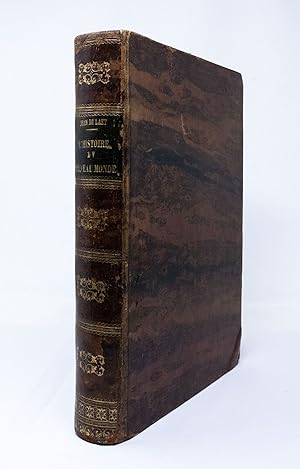

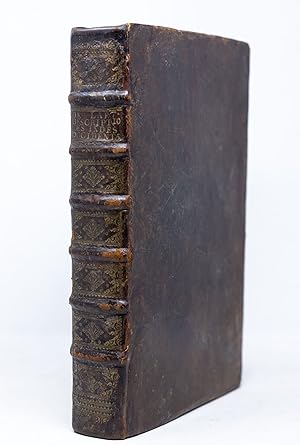
![Image du vendeur pour [Dialogo] Systema cosmicum in quo quatuor dialogis, de duobus maximis mundi systematibus, ptolemaico & copernicano, utriusq; rationibus philosophicis ac naturalibus indefinite propositis, disseritur Accessit appendix gemina, qua SS. Scripturæ dicta cum terræ mobilitate conciliantur mis en vente par SOPHIA RARE BOOKS](https://pictures.abebooks.com/inventory/md/md31000842426.jpg)
